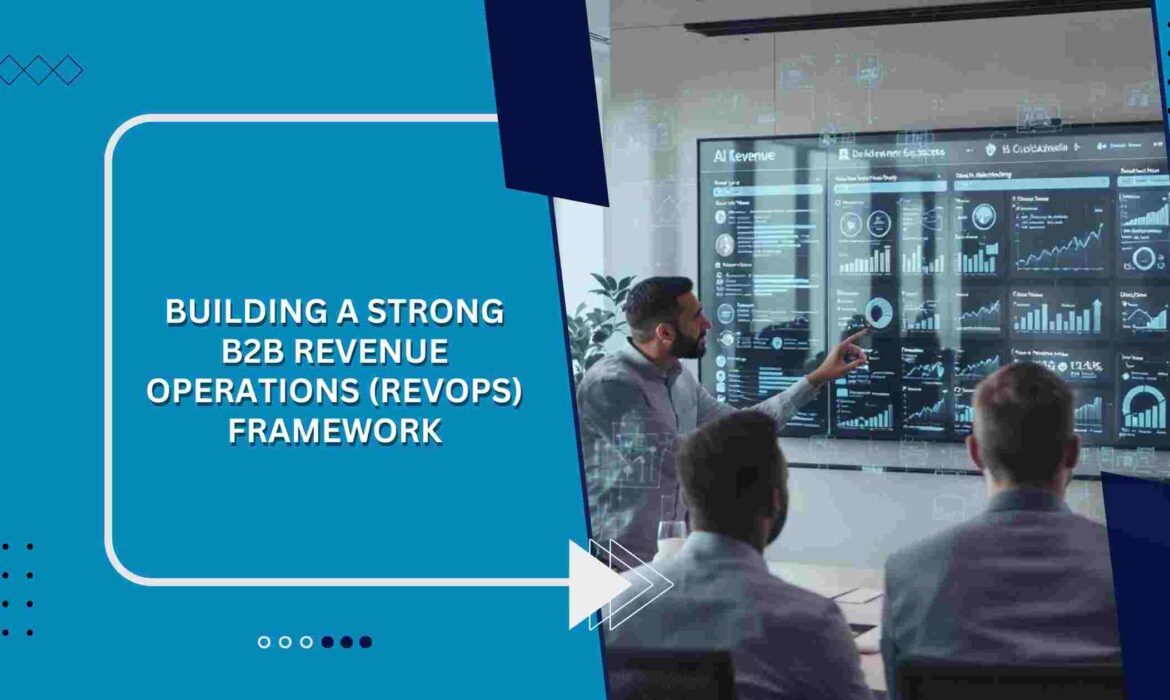In the fast-paced world of B2B, companies often find themselves trapped in silos where sales, marketing, and customer success teams work independently, each chasing its own goals. This misalignment creates friction, reduces efficiency, and ultimately stalls revenue growth. That’s where B2B Revenue Operations (RevOps) steps in a holistic framework designed to unify all revenue-driving functions under one strategy.
RevOps is not just a buzzword; it’s a fundamental shift in how organizations operate. Instead of treating sales, marketing, and customer success as separate lanes, B2B Revenue Operations brings them together to work in harmony, guided by shared metrics and streamlined processes. For businesses looking to scale efficiently, this framework is no longer optional it’s essential.
Let’s dive into how companies can move from leads to revenue by building a robust RevOps framework that transforms fragmented processes into a revenue-generating machine.
What is B2B Revenue Operations (RevOps)?
At its core, B2B Revenue Operations is the alignment of people, processes, technology, and data across all revenue-generating departments. Instead of managing sales, marketing, and customer success independently, RevOps integrates them under a centralized model that ensures consistency, efficiency, and predictable growth.
Think of RevOps as the operating system of a business. It coordinates the efforts of multiple functions, ensuring they are not competing with each other but working collectively toward one outcome revenue growth.
Key objectives of B2B Revenue Operations include:
- Eliminating data silos and creating a single source of truth.
- Improving the buyer journey from lead to customer retention.
- Enhancing forecasting accuracy and pipeline visibility.
- Driving operational efficiency and reducing wasted resources.
Why B2B Revenue Operations Matters Today
Modern buyers demand seamless experiences. They don’t distinguish between sales, marketing, or customer success they just expect value at every touchpoint. Without RevOps, organizations risk disjointed communication, inconsistent messaging, and poor customer experiences.
The importance of B2B Revenue Operations lies in its ability to:
- Create Cross-Functional Alignment
By centralizing strategy, RevOps eliminates finger-pointing between departments and fosters collaboration around shared goals. - Leverage Data for Better Decisions
Data is the lifeblood of revenue growth. RevOps consolidates insights from all customer touchpoints, giving leaders a holistic view of performance. - Improve Forecast Accuracy
With unified metrics and integrated systems, businesses gain more reliable forecasts, which are critical for scaling sustainably. - Boost Operational Efficiency
Standardized processes reduce redundancies and ensure every lead is nurtured effectively.
Core Pillars of a Strong B2B Revenue Operations Framework
Building an effective B2B Revenue Operations framework requires focusing on four core pillars. These elements serve as the foundation for revenue growth.
1. People
People are at the heart of RevOps. A successful framework requires cross-functional teams with clearly defined roles. While traditional silos separate marketing, sales, and customer success, RevOps unites them under shared accountability.
- Appoint RevOps leaders who act as the bridge between departments.
- Define responsibilities that focus on outcomes, not functions.
- Encourage a culture of collaboration and transparency.
2. Process
Processes determine how smoothly leads flow through the funnel. Inconsistent workflows can create bottlenecks that cost both time and revenue.
- Standardize lead qualification criteria across teams.
- Create unified workflows for customer onboarding and retention.
- Document processes to ensure repeatability and scalability.
3. Technology
RevOps is powered by technology, but too many tools can create complexity. The goal is to build a connected tech stack that provides a seamless experience.
- Invest in a CRM as the central hub for all revenue activities.
- Integrate marketing automation, sales engagement, and customer success platforms.
- Use AI and analytics to provide real-time insights and predictive forecasting.
4. Data
Data is the glue that holds RevOps together. Without it, decision-making becomes guesswork.
- Create a single source of truth by consolidating data from multiple systems.
- Use data governance policies to maintain accuracy and compliance.
- Leverage analytics to measure ROI at every stage of the revenue funnel.
Steps to Build a B2B Revenue Operations Framework
Transitioning to B2B Revenue Operations doesn’t happen overnight. It requires a systematic approach to unify teams and align processes. Here’s a step-by-step guide:
Step 1: Audit Current Processes
Begin by assessing your existing workflows across sales, marketing, and customer success. Identify bottlenecks, redundancies, and areas where misalignment is impacting revenue.
Step 2: Define Unified Goals and Metrics
Create shared KPIs such as pipeline velocity, customer lifetime value, and revenue retention. These metrics ensure all departments are working toward the same objectives.
Step 3: Build a Centralized Data Infrastructure
Establish a data hub that integrates insights from CRM, marketing automation, and support systems. This ensures consistency in reporting and forecasting.
Step 4: Optimize Technology Stack
Evaluate tools for overlap and redundancy. Choose platforms that integrate seamlessly to provide end-to-end visibility.
Step 5: Establish Clear Governance
Set policies around data ownership, reporting standards, and accountability. Governance ensures that the RevOps framework remains sustainable as the organization grows.
Step 6: Drive Cultural Adoption
Change management is critical. Train teams on the benefits of RevOps, foster collaboration, and reward behaviors that align with revenue outcomes.
Common Challenges in Implementing B2B Revenue Operations
While the advantages of adopting a B2B Revenue Operations (RevOps) framework are undeniable, organizations often encounter significant hurdles during implementation. Transitioning from traditional siloed operations to a unified revenue model requires not only structural changes but also a cultural shift across departments. Below are some of the most common challenges businesses face:
1. Resistance to Change
One of the biggest barriers is cultural resistance. Teams that have historically operated in silos marketing focusing on lead generation, sales on closing deals, and customer success on retention often struggle to adapt to shared goals and responsibilities. Employees may feel threatened by changes in reporting structures or worry about losing control over their processes. Overcoming this challenge requires strong leadership, consistent communication about the value of RevOps, and providing training that helps teams embrace a collaborative mindset.
2. Technology Overload
Many companies adopt multiple tools across sales, marketing, and customer success without proper integration. This “tool sprawl” creates inefficiencies, as teams juggle different systems that don’t talk to each other. For example, marketing may track campaigns in one platform, sales manage pipelines in another, and customer success relies on a third system for retention metrics. Without centralization, critical insights are lost, and productivity suffers. Building an effective B2B Revenue Operations framework means streamlining the tech stack, ensuring tools are integrated, and establishing a single source of truth.
3. Data Quality Issues
Accurate, consistent data is the foundation of RevOps success. However, many businesses face problems with incomplete, outdated, or duplicated records across systems. Poor data quality makes it difficult to measure ROI, forecast revenue accurately, or make informed decisions. Inconsistent definitions of metrics such as what qualifies as a “sales-ready lead” can also cause friction between departments. To address this, organizations must establish strict data governance practices, invest in cleansing and enrichment tools, and create unified reporting standards.
4. Leadership Alignment
RevOps cannot succeed without strong executive buy-in. Leadership misalignment where sales, marketing, and customer success leaders pursue their own departmental priorities often stalls progress. Without a shared vision at the top, teams default to old habits and silos re-emerge. Gaining leadership alignment involves not only demonstrating the financial impact of B2B Revenue Operations but also fostering accountability among executives to champion the cultural and operational changes needed for success.
The Future of B2B Revenue Operations
As businesses increasingly adopt digital-first strategies, B2B Revenue Operations will evolve into a strategic necessity rather than an optional framework. Emerging technologies like AI, machine learning, and predictive analytics will further empower RevOps by automating repetitive tasks and providing deeper insights into buyer behavior.
Companies that invest in RevOps today will not only accelerate revenue growth but also build a competitive advantage that sets them apart in the market.
From generating leads to driving sustainable revenue, B2B Revenue Operations offers the blueprint for modern growth. By unifying people, processes, technology, and data, organizations can create predictable revenue streams and deliver exceptional customer experiences.
Ready to transform your revenue operations and unlock growth? Connect with Acceligize today and start building a RevOps framework that drives results.




